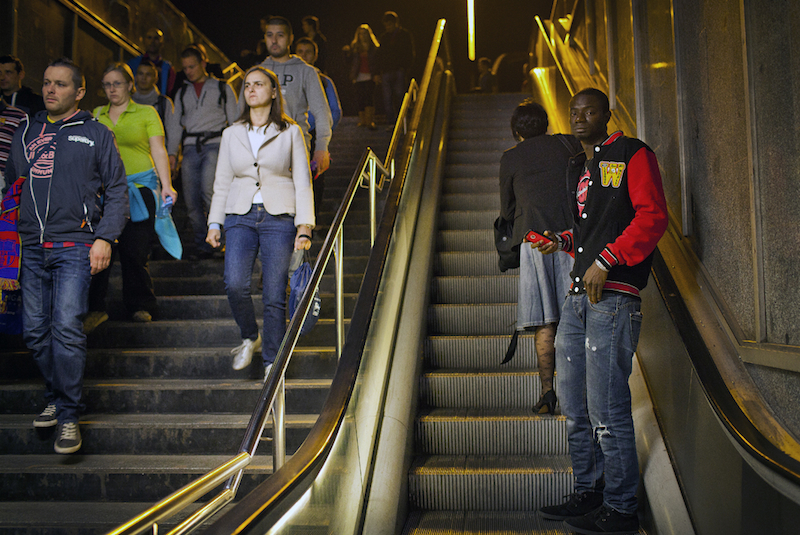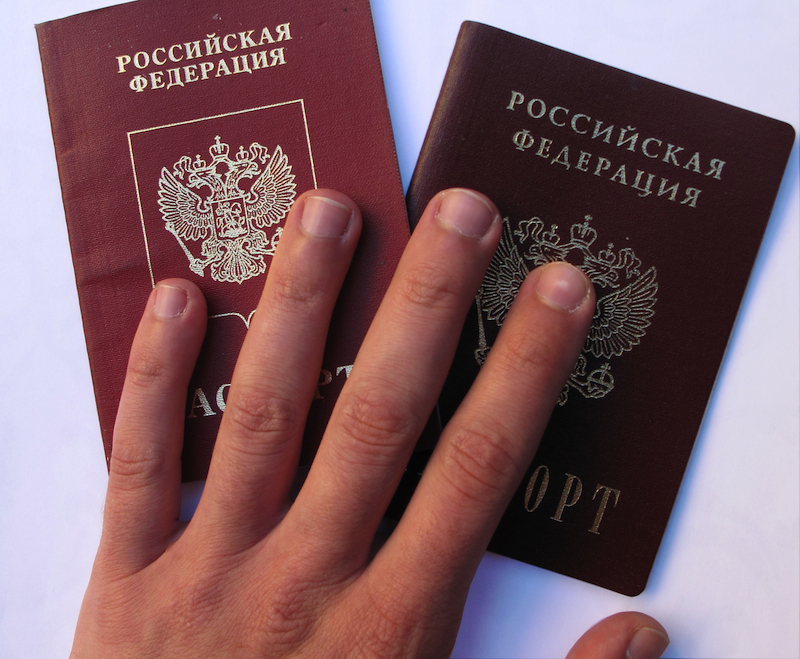
Sydelle Willow Smith, Seykou, 2013; photograph. In conjunction with “Making Neighborhoods.” Courtesy the artist.
In November 2013, I joined three artists in Barcelona, Spain, to work on a collaborative project about the city’s visible and invisible communities. “Making Neighborhoods” was first proposed by the South African photographer and filmmaker Sydelle Willow Smith as a multidisciplinary project with the city’s African immigrant population, with support from the Africa Centre and the Spanish Embassy in South Africa. Joining Smith was Thomas Strickland, a Montreal-based architect, art historian, and curator who, in conjunction with the Catalan Association for the Integration of Homosexual, Bisexual, and Transgender Immigrants (ACATHI), worked with LGBT exiles with refugee status on an urban intervention project. Andrei Fărcăşanu, a Romanian photographer living in Barcelona, took portraits of residents in the Gràcia district, to be enlarged to life-size and wheat-pasted onto buildings where they lived. We were aided by Mireia Estrada, the director of Jiwar Creation and Society, the project’s vital local partner, who coordinated and culturally and linguistically translated for the linked projects. I was there to witness and expose the projects’ connections through the medium (or more accurately, the sensibility) of writing.
We wanted to explore how communities are built and contribute to the overall presence of a city. Oddly enough, the creative process mirrored the experience of multiple communities existing alongside each other: interdependent, interactive, and yet not entirely integrated. In addition to the linked but autonomous nature of the social-documentary projects within “Making Neighborhoods,” the participants were also collaborators, producing their own documentation for the final exhibition. Smith gave disposable cameras to African residents from Mali, Senegal, Ghana, and Equatorial Guinea, who each had radically different experiences, immigration statuses, reasons for participating, and financial situations in Spain’s faltering economy. Their photographic subjects ranged from artistic and conceptual images to everyday social gatherings, to communal dumpster-diving for food. Strickland’s project reflected the multiple perspectives, dreams, and desires of gay, lesbian, and transgender refugees of varying nationalities and ages, such as Ruben, a highly influential AIDS activist and Barcelona resident since the 1970s, and Andrei, who’d fled Russia six weeks earlier and doesn’t know when, if ever, he will be able to return.
Sydelle Willow Smith, Vecinos (Neighbours), 2013. Courtesy the artist.
This moving and broadly ranging collaboration resulted in Smith’s short documentary, Vecinos, Fărcăşanu’s portraits, Strickland’s urban interventions and new mapping systems, and numerous participant photographs and personal accounts—the means by which we communicated with Barcelona about itself, its policies, and lesser-known and -understood populations. It culminated in a public discussion and an exhibition in the city hall, where one pays parking tickets and obtains work permits: a hub for both residents and recently arrived immigrants.
It seemed odd that we would do a neighborhood project in a city with which we were all, to varying degrees, largely unfamiliar; for this, local collaborating institutions and individuals were essential. But our cultural disorientation, a very raw, daily experience of foreignness, added resonance and depth to a project that was largely about immigration. The project’s roots and production were also personally significant, in the way all art is on some level. Smith was interested in the friction between European and African identities; as a white South African, she often encounters resistance when identifying herself as African, and her practice explores notions of identity in relationship to place and fraught colonial histories. Strickland’s introduction to Barcelona was almost entirely determined by his local collaborators, mapping routes from their homes to sites that were meaningful to them, where together they would leave a symbolic gift, their shared mark on the landscape. Fărcăşanu’s neighborhood project spoke to his experience of immigrating to a new city: over time, what appear to be faceless buildings reveal their inhabitants, a network of friends, associates, conversations, and memories, which radically alter the look of a street, an entire neighborhood.

Thomas Strickland, Andrei’s Hand on His Passport, 2013; photograph. In conjunction with “Making Neighborhoods.” Courtesy the artist.
As a fiction and arts writer, my role in the project was largely undefined. Consequently, I did what I usually do, which is just to pay attention, talk to people, and emotionally connect with them, which often happens without me realizing it, creating subconscious imprints that may or may not emerge later in the work. Writing deifies language; it is fitting words to experience. But in this project, language itself became very mutable, fluid, and somehow less important, a tool: I spoke in Spanish or English and wrote in English, all of which was translated into Catalan for the public presentation and exhibition. It’s extraordinary how much can be communicated without access to a battalion of words, and “Making Neighborhoods” was clearly about the desire we all have to connect with each other. Because even with a shared space and a common tongue, we still construct so many barriers to prevent ourselves from doing it.



